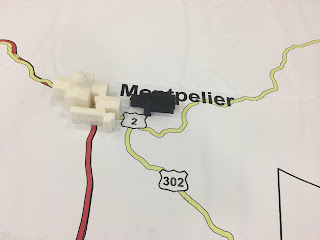
I love that the last day of the March is for Making Series (30 blog post in 30 days to inspire us to keep on making) coincides with one of my favorite examples of creating, making, and learning - the annual 3D Vermont event!

Learning from each other
For the past four years, a large floor map of Vermont is rolled out on the floor of JUDD gymnasium at Vermont Technical College as the culminating event in the 3D Vermont project. Teams of middle school and high school students place 3D printed models that they have created (to scale) of historic buildings at various locations on the map! They then proceed to stations around the gym where they share their research about each of historical locations they have researched as part of this project. Guest and judges circulate around the room listening to each team share what they learned while researching and modeling historic buildings in 3D.
Video Tour of the Floor Map
This year's group of students designed their models using a variety of different tools including TinkerCad, SketchUp, Fusion 360 and SolidWorks. Here's a short video tour of some of the buildings that the students shared.
A close up look of some of the models.
Students used a variety of different tools (both analog and digital) to get accurate measurements to model their building to scale.
 |
| Taking measurements with digital technology. |
 |
| Applying our math skills! |
Students took care to replicate not only the buildings but also the portions of the environments that were part of the historical narrative.
 |
| The story behind the boat and the bridge and its ghost! |
 |
| Using 3D finishing techniques to put our building into context. |
Many of the students also modeled the contents found in some of their building.
 |
| A telescope |
 |
| Taxidermy artifacts located in the museum |
And it did not take long for anyone listening to these students to realize that this is NOT a competition about your ability to create a 3D model! As you can see from this video, this project is about the the integrated learning that occurs when students communicate what they are learning through a combination of tools and processes that lead to hands on- minds on learning!
Amazing evidence of cross disciplinary learning.
Evidence of students's research ranged from brochures, posters, photo albums, and Google Slide such as these Google Slides shows
to extensive websites such as this one from the award winning team from Windsor high school http://www.windsor3dprinting.com/
to carefully matted photos and primary document replicas
to actual historical artifacts.
One school even included a VR (virtual reality) tour!
 The competition started with a project that Mike Hathorn from Hartford High School designed for his high school history class. Student researched historic buildings in their town of Hartford, Vermont and shared their research by creating a presentation about the building historical significance along with a 3D printed model of the buildings that they designed. Over the past few years the concept has expanded to include middle schools and high schools from around Vermont!
The competition started with a project that Mike Hathorn from Hartford High School designed for his high school history class. Student researched historic buildings in their town of Hartford, Vermont and shared their research by creating a presentation about the building historical significance along with a 3D printed model of the buildings that they designed. Over the past few years the concept has expanded to include middle schools and high schools from around Vermont!
Mike Hathorn on the origins of 3D Vermont
And this year's winners....
Middle School Division
3rd place Mater Christi Middle School
2nd place - St. Albans City and Town School
1st place - Castleton School
High School Division
Honorable mention ~ Montpelier High School
First Place ~ Windsor High School
Past Winners
Additional media clips from 3D Vermont 2018
















